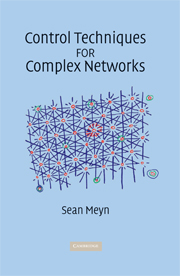Book contents
- Frontmatter
- Contents
- List of Illustrations
- Preface
- Dedication
- CONTROL TECHNIQUES FOR COMPLEX NETWORKS
- 1 Introduction
- Part I Modeling and Control
- Part II Workload
- Part III Stability and Performance
- 8 Foster–Lyapunov Techniques
- 9 Optimization
- 10 ODE Methods
- 11 Simulation and Learning
- Appendix: Markov Models
- Bibliography
- Index
11 - Simulation and Learning
from Part III - Stability and Performance
Published online by Cambridge University Press: 17 March 2011
- Frontmatter
- Contents
- List of Illustrations
- Preface
- Dedication
- CONTROL TECHNIQUES FOR COMPLEX NETWORKS
- 1 Introduction
- Part I Modeling and Control
- Part II Workload
- Part III Stability and Performance
- 8 Foster–Lyapunov Techniques
- 9 Optimization
- 10 ODE Methods
- 11 Simulation and Learning
- Appendix: Markov Models
- Bibliography
- Index
Summary
The chief motivation for performance evaluation is to compare candidate policies. For example, many of the policies described in Chapters 4 and 10 depend upon static or dynamic safety-stock parameters, and we would like to know how to choose the best parameter values in order to optimize performance.
We have seen in Chapter 8 that linear programming techniques can provide bounds on performance for the CRW model. This approach can be successfully applied in network models with many buffers and stations. However, linear programming techniques are not flexible with respect to the operating policy. For example, in order to distinguish similar policies with different safety-stock levels, constraints must be introduced in the LP specific to each safety-stock parameter. It is not clear how to introduce such constraints in the approaches that have been developed to date.
While not a topic of this book, there are classes of networks for which the invariant measure π is known. The crucial property required is reversibility, from which it follows that π has a product form, π(x) = π1(x1) … πℓ(xℓ) for x ∈ X [502, 290]. Outside of this very special class of models the computation of π is essentially impossible in large networks. We are thus led to simulation techniques to evaluate performance.
The simulation techniques surveyed in this chapter all involve a Markov chain X on a state space X.
- Type
- Chapter
- Information
- Control Techniques for Complex Networks , pp. 452 - 504Publisher: Cambridge University PressPrint publication year: 2007

